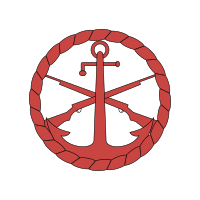| San Marco Marine Brigade | |
|---|---|
| Brigata Marina "San Marco" | |
 Badge of Italian naval riflemen | |
| Active | 1550-1914 (as the La Marina Regiment) 1914-1919 (as the Brigata Marina) 1919-1956 1965-1994 (as the Marina Battaglione "San Marco") 1994–2013 (as the San Marco Regiment) 2013-Present (as the San Marco Marine Brigade) |
| Country | |
| Branch | |
| Role | Naval infantry |
| Size | ca. 3,800 |
| Garrison/HQ | Caserma “Carlotto”, Brindisi, Italy |
| Nickname(s) | Marò |
| Patron | St. Mark |
| Motto(s) | "PER MARE, PER TERRAM" |
| March | "Pace armata" (by Luigi Musso) |
| Commanders | |
| Current commander | Rear admiral Massimiliano Giuseppe Grazioso |
The "San Marco" Marine Brigade (Italian: Brigata Marina "San Marco") is an amphibious formation of the Italian Navy, has been brigade since 2013 but the amphibious corps existed since 1915, reorganizing the Navy Landing Force. [1] It has its command in Brindisi. They are the marines of the Italian Navy.
Contents
It is a joint formation, framed within the amphibious projection force, whose commander is the same admiral who serves as commander of the San Marco Brigade.




